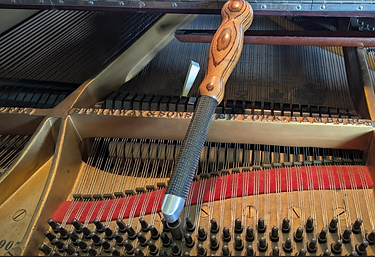Whole Tone Open String Tuning
the tone, the whole tone and nothing but the tone

The Art of Piano Tuning: Listening Beyond the Temperament Strip
One common technique in piano tuning is the use of a temperament strip—a strip of wool felt used to mute the outer two strings of three-string groups called "unisons". By isolating a single string per note, tuning seems simpler when setting the proper spacing of musical intervals. Once these pitches are established, the felt mute is removed, and the outer strings are tuned to match the center one.
I relied on temperament strips for years, but as my skill and sensitivity improved, I discovered their limitations. The intervals would drift slightly when the strip was removed, and elite technicians advocated using only one or two single mutes. This intrigued me, and I began to experiment.
Now, well into my third decade as a piano technician, I am convinced that the highest level of accuracy and refinement comes from listening to the entire sound of the unisons while tuning. The pitch of a note often shifts subtly when all three strings are engaged. I’ve also found that sophisticated tuning software struggles to measure a full unison as precisely as a single string, reinforcing the importance of trusting the ear.
While electronic tuning aids have their place when used strategically, they can never replace the ear. The true essence of piano tuning lies in actively listening to the complete sound, ensuring each note and interval resonates at its fullest potential.
The Whole Tone TuninG Advantage
My current pattern is strongly influenced by practices promoted by Rick Butler, RPT former technician at the White House and The Kennedy Center who, in his retirement, has focused on educating the next generation of technicians.

"I'll Take the Fifth!"
Rick’s approach prioritizes the clarity of the fifths in order to bring out the most beautiful tone. The fifths become their own “mini-temperaments” and are the building blocks of the entire tuning. This requires particular attention to the balance of the major and minor 3rds that fit within the fifth.
The “one mute” open unison approach becomes an advantage when making the slightest adjustments in order to polish the intervals. It allows for the “unison shimming” or “cracking the unison” technique to move multiple strings together in subtle ways. I am convinced that using the sound of an ever-so-slightly out of tune unison is the most efficient and accurate way to move an entire unison's pitch.
LINK TO EXCELLENT DISCUSSION ON THIS TECHNIQUE BY MARK CERISANO
This technique is greatly enhanced when the hammers are properly shaped and well-mated to the strings. More often than not, I find that when piano hammers hit the three-string unisons it is not hitting them all at the same time, either due to strings not being level, or the hammer contact surface not being parallel to the string plane.

Improperly mated hammers give the note an out-of-tune quality even when the strings are tuned as well as can be. For this reason, the one mute approach motivates the technician to improve the hammer to string mating in order to more easily and accurately tune the piano. It is also considered the foundation for voicing and getting the most musical sound from the piano.